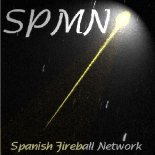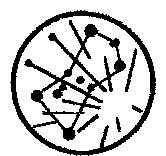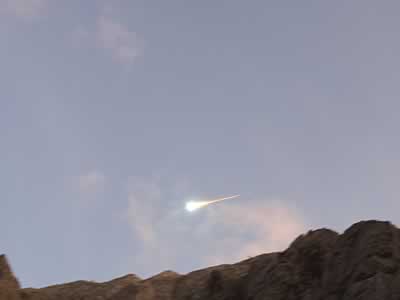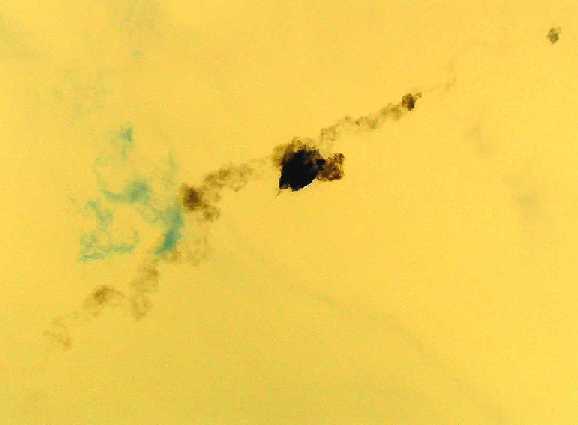4 January 2004, ~16:46 UTC
 |
 |
 |
Hundreds of people across the Iberian peninsula witnessed a spectacular fireball in the late afternoon of January 4, 2004. Sightings were reported all across the peninsula from the Nortwest Atlantic coast to the southeast Mediterranean coast of Spain. Loud sonic booms were heard. The event is currently being researched by the Spanish Photographic Meteor Network (SPMN) (Dr. Josep M. Trigo-Rodriguez et al.). The information on this DMS webpage is a combination of information kindly made available by this organization, and some of our own early analysis and observations regarding information and data (the Leon video) gathered from Spanish and international press reports shortly after the event. It is updated whenever new information becomes available. An English bulletin on the fireball by the Spanish SPMN can be found here.

The fireball was captured on video by an amateur filmer in León (click here to see the RealPlayer streaming video (source: NOS), and here for an animated GIF version). It shows a fast moving, very bright fireball with several flares. Please note that a second video circulating does not show this fireball, but rather a sunlit aircraft contrail filmed the day before.

Impressive image obtained from the Leon mountains by Salvador Diez. Courtesy of Salvador Diez and the Spanish Fireball and Meteorite Recovery Network (SPMN)

Impressive image of the bolides' dust trail obtained by Jesus Martín from Villalbeto de la Peña (Palencia). Image processing and enhancement by Dr. Josep M. Trigo-Rodriguez (UCLA). Several explosions throughout the route are apparent. Notice the presence of low clouds (greenish) which distinguishes clearly after suitable treatment of the image. Image courtesy of the Network of Investigation on Bolides and Meteorites (SPMN).
An early report on a possible meteorite fragment turned out to be spurious. However, on January 20, the SPMN (Josep M. Trigo-Rodriguez et al.) and Spanish newsmedia (e.g. El Mundo) brought the news that two meteorite fragments have been recovered in the northern part of Palencia province. Initial tests by Dr. Garcia Guinea (CSIC) suggest these are true meteorites. Although there was some initial confusion in the media reports, the test results reported in El Mundo and the photographs of the two objects suggest it probably are stony meteorites. Further investigation by Dr Jordi Llorca Pique & Dr. Javier Garcia Guinea (Museo Nacional Ciencias Naturales-CSIC) is in progress. A picture of the two recovered stones can be found at the SPMN website.

First images of the two first recovered meteorites obtained by Dr. Javier Garcia Guinea (Museo Nacional Ciencias Naturales-CSIC).
A number of fires across Spain were reported and thought to be connected to the event. This is highly unlikely. Meteorites do not start fires: that is one of the most persistent misunderstandings about meteorites. Meteorites are cold upon landing. They do not reach the ground incandescent. Moreover, the results on the location of the fireball are completely incompatible with most of the reported locations of 'fires'. Research by Dr Jesus Martinez-Frias of the Spanish Forum on Meteorites and Planetary Geology of the Spanish Research Counsil has also discounted the early report of "impact craters" in mid-Spain.
Spanish newsmedia and REUTERS initially reported that the fireball traveled from northwest Spain to the southwestern Mediterranean coast. This seems to be incorrect: the general NW-SE direction merely is the distribution of eyewitness accounts, which erroneously was taken to represent the fireball's path. A NW-SE trajectory is incompatible with the León video record. In this video record, the fireball can be seen moving at an ~45 degree angle from the right to the left. It also shows an appartment building of which the top is sunlit, and the lower part in the shade. With the sun setting in the southwest, this point out that the video-footage shows a part of the sky looking towards the Northeast, oposite the sun. If the NW-SE trajectory would be correct, the fireball should have moved from the left to the right, opposite to what it does in the video. In a message on the meteorobs mailinglist on January 7 (see here), Victor R. Ruiz pointed out that the moon is visible in the León video, just left of the sunlit appartement building. It is not well visible in the RealPlayer video linked above, but clearly visible in the still image at the top of this page: and it can be very well seen in animated GIF version of the video at http://galeon.com/meteorvideo/meteorito.gif. It is not a reflection of the fireball, as it is fixed in position. This indeed, clearly is the moon. This clarified the viewing direction of the video and confirmed an image viewing direction close to the northeast. At León, the moon was located in azimuth 78 degrees (east-northeast) at an altitude of 22 degrees at 16:45 UTC. This points out that our early main conclusions that a) the fireball is not a Quadrantid stream member (see below); and b) the trajectory was not NW-SE (see above) are correct. The direction also points out that the location of this fireball must be sought near the border of the Asturia and Spanish Basque provinces, in the North, and not in central Spain. This conclusion is shared and considerably strenghtened by additional data, by the Spanish researchers of the SPMN (Dr. Josep M. Trigo-Rodriguez (UCLA), Dr Jose Luis Ortiz of the Instituto de Astrofisica de Andalucia, Dr Jordi Llorca Pique of the University of Barcelona and the "Institut d'Estudis Espacials de Catalunya" (IEEC), and Dr Jose Angel Docobo (Astronomical Observatory Ramon Maria Aller-University of Santiago de Compostela) who base their conclusions on a much more definite analysis of a much larger dataset than we had at our disposal in the days directly after the fireball apparition. See the update on the trajectory below.
The same observations with respect to the León video as pointed out in the previous paragraph, show that the fireball cannot be associated with the Quadrantid meteor stream, which peaks on January 4 annually. With the stream radiant at 12 degrees altitude in the northwest, the fireball should have moved left to right in the video, not right to left as it does. It's altitude and angle of descend are much too steep too (it should actually go upward -and in an opposite direction- if it would have come from the Quadrantid radiant). This therefore classifies as a 'sporadic' (non stream-related) fireball, unless later analysis might line it up with another stream than the Quadrantids (which is possible - several minor meteor streams are active early January).
It can be ruled out that this was satellite debris, for two reasons. One is that the fireball on the Leon video is much too fast for satellite debris re-entering. The other reason is that there are no suitable decay candidates. Upon checking USSTRATCOM decay notices, only two pieces of space debris were near decay around that time: a small piece of Ariane 44 debris and a 60 kg Kosmos 2397 auxilliary motor. The Ariane debris piece is no candidate because its orbit, with an inclination of only 8 degrees, does never bring it over Spain. The Kosmos 2397 motor made a pass over Spain 1.5 hours earlier than the fireball but was over Australia at the time of the fireball: moreover it was still in orbit and tracked for several days after the fireball by USSTRATCOM (it decayed on January 8). There are no other decay candidates around this date (see also the Spanish research group's bulletin). Since an object capable of creating a fireball of this brighnes would certainly be tracked by USSTRATCOM (which starts to track pieces in Low Earth Orbit from about 10 cm diameter), the only remote option would be a decay of a classified object. However, as mentioned the speed of the fireball on the video is much too high for it to be satellite debris. So it can be ruled out 100% that this was an artificial object (note added 24/01: the reported recovery of meteorites underlines this even more).
On the Spanish SPMN website the first trajectory results are now presented. They also provide some very interesting speculation about the possibility that this fireball might have moved in a similar orbit as that of the 3 January 1970 Lost City meteorite, a H5 chondrite. The still very preliminary results on the radiant position of the Spanish fireball appear to be somewhat similar to that of Lost City.
Information input by Dr. Josep M. Trigo-Rodriguez and Dr. Jesus Martinez-Frias is gratefully acknowledged
|